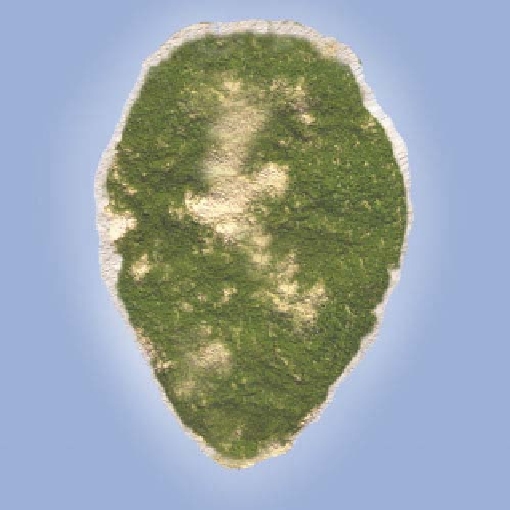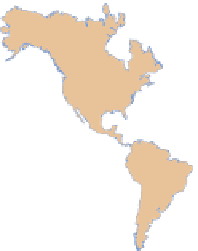Geoscience Reference
In-Depth Information
mately 10°C (18°F). Predictably, the tropical regions are warm,
with a slight northerly migration of the 25°C (77°F) isotherm.
Again, the only variation from this overall tropical pattern is the
relatively cool temperatures that follow the Andes Mountains
and Humboldt Current in South America.
Why do these annual geographical patterns exist? The an-
swer lies in the holistic interactions of the factors discussed so
far, including seasonality, insolation, net radiation, latitude, the
maritime vs. continental effect, and the environmental lapse
rate in the troposphere. Some patterns are easy to explain. For
example, the consistently warm temperatures in the tropics are
naturally a function of high Sun angles and associated intense
radiation all year long. As already noted, the exception to this
tropical pattern exists along the axis of the Andes Mountains.
This geography demonstrates that secondary variables—in this
case, the troposphere's negative lapse rate and its cooling effect
at progressively higher altitudes—also influence temperature
patterns.
Another clear pattern is the extreme range of temperature at
high latitudes in the Northern Hemisphere, which is easily ex-
plained by the highly variable amount of radiation received over
the year due to changes in orbital position and the angle of in-
cidence. It should also make sense that temperatures along the
Water
Land
Water
15
°
C (59
°
F)
Isotherm in
July
Large latitude shift
over land
d
h
d
15
°
C (59
°
F)
Isotherm in
January
Small latitude
shift over
water
N
W
E
0
1,000 km
S
620 mi
Figure 5.10 Theoretical seasonal migration of the 15°C (59°F)
isotherm on a hypothetical continent.
This hypothetical con-
tinent straddles the Equator, with 15°C (59°F) isotherms in each
hemisphere. Notice how far the isotherm migrates over the conti-
nent compared to its movement over the oceans.
-15
-20
-35
-10
-30
-30
-5
0
-35
-45
-40
-35
-50
ter of the United States in the interior of the continent, but crosses
into the Pacific Ocean much farther to the north. In other words,
January temperatures are much warmer at higher latitudes along
the west coast of North America than in the continental interior.
As expected for the Southern Hemisphere summer, mid-
to high-latitude temperatures in that part of the world are also
relatively warm, ranging from 10°C (50°F) on the southern
tip of South America to 30°C (86°F) in the core of Australia.
Predictably, temperatures in most of the tropical regions are
warm, with an average of about 25°C (77°F) over a large part of
the globe. The only significant deviation from this overall tropi-
cal pattern exists in western South America, where cool tem-
peratures penetrate into very low latitudes. This pattern exists
in part because the Andes Mountains follow much of the west
coast of South America and are over 6000 m (19,680 ft) high.
In addition, the cold Humboldt Current flows northward along
the coast, which contributes to cooler temperatures in this area.
Now turn your attention to the July image in Figure 5.11.
What different patterns emerge in this diagram? For one, notice
that the Northern Hemisphere landmasses are much warmer
than they were in January, with temperatures reaching 10°C
(50°F) in northeastern Asia and northern Canada. In other
words, a 60°C (108°F) annual range of temperature exists at
high latitudes in the Northern Hemisphere. Similarly, the inte-
rior of the United States is much warmer as well. Interestingly,
the high latitudes in the Southern Hemisphere do not experi-
ence such a range of temperature. Winter temperatures on the
southern tip of South America, for example, cool to only about
-30
-25
-30
-25
0
5
-20
-15
5
-10
10
10
-5
20
15
15
10
20
15
20
25
25
25
25
25
25
25
25
30
20
20
25
20
15
15
10
10
10
5
January
5
-10
10
-5
0
10
10
15
5
15
20
25
15
20
20
20
25
30
35
30
25
25
30
25
20
25
20
25
25
20
20
20
15
15
15
10
15
10
10
5
5
0
5
0
0
July
Figure 5.11 January and July distribution of surface air
temperatures on Earth.
Notice the geographic patterns and
variations that occur between months. Blue isotherms indicate































































































































































































































































































































































































































































































































































































































































































